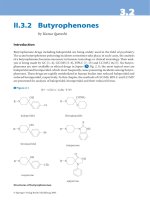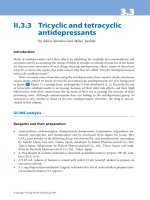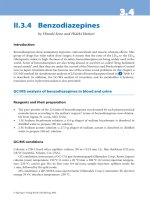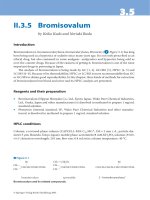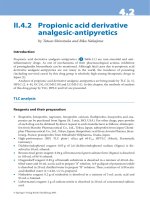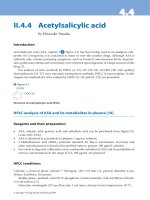Tài liệu Indira Gandhi Matritva Sahyog Yojana -A Conditional Maternity Benefit Scheme Indira Gandhi Matritva Sahyog Yojana A Conditional Maternity Benefit Scheme Indira Gandhi Matritva Sahyog Yojana A Conditional Maternity Benefit Scheme docx
Bạn đang xem bản rút gọn của tài liệu. Xem và tải ngay bản đầy đủ của tài liệu tại đây (759.15 KB, 67 trang )
Indira Gandhi Matritva Sahyog Yojana
-A Conditional Maternity Benefit Scheme
A
Training Module
Towards a new dawn
Ministry of Women and Child Development
Government of India
New Delhi
1. INTRODUCTION
Undernutrition continues to adversely affect majority of women in India. In India, every third
woman is undernourished and every second woman is anemic1. When poor nutrition starts inutero, it extends throughout the life cycle, particularly in women. Owing to economic and social
distress many women continue to work to earn a living for their family right up to the last days of
their pregnancy. Furthermore, they resume working soon after childbirth, even though their
bodies might not permit it, thus preventing their bodies from fully recovering on one hand, and
also impeding their ability to exclusively breastfeed their young infant in the first six months.
Although Janani Suraksha Yojana (JSY) by Ministry of Health and Family Welfare provides a
one-time cash incentive to a pregnant woman for institutional delivery/home delivery through
skilled assistance, however, it does not address wage loss during pregnancy and after delivery.
In view of the above, the Ministry of Women and Child Development (MWCD) formulated a new
Scheme for pregnant and lactating mothers called Indira Gandhi Matritva Sahyog Yojana
(IGMSY) – a Conditional Maternity Benefit Scheme. Under this Scheme, a cash incentive of
`4000 will be provided directly to women 19 years and above for the first two live births subject
to the woman fulfilling specific conditions relating to maternal child health and nutrition. Cash
incentive will be provided in three installments, between the second trimester of pregnancy till
the infant completes 6 months of age.
IGMSY is a Centrally Sponsored Scheme under which full grant-in-aid would be provided to
State Government (SGs)/Union Territories (UTs). It has been approved by the Government on
pilot basis in 52 selected districts across the country. The focal point of implementation will be
the Anganwadi Centre (AWC).
ABOUT THE MODULE:
•
The module is designed based on the guidelines of the Scheme prepared by MWCD,
Government of India as a reference and converts information from the guidelines into
specific sessions to provide conceptual understanding on how to implement; monitor &
evaluate the Scheme and reporting process to be followed.
•
The module comprises four sessions for the ICDS functionaries and trainers.
1
National Family Health Survey-3, 2005-06: All India. Volume I. Mumbai: International Institute of Population Sciences; 2008.
2
WHO CAN USE THIS MODULE?
•
This module can be used by the Master Trainers and Trainers of MLTCs ( Middle Level
Training Centers) and AWTCs (Anganwadi Workers Training Centers) for training of ICDS
functionaries on Indira Gandhi Matritva Sahyog Yojana.(IGMSY)
•
Each session has the following components:
•
Session title
•
Objectives
•
Time required
•
Content
•
Materials required
•
Training method
•
Learning outcome
•
Instructions for trainer
•
Supporting information
•
Summing up
INSTRUCTIONS FOR TRAINERS:
Dear Trainers,
•
The training module has been prepared to help you in conducting one day training on
IGMSY Scheme.
•
You are expected to go through the entire module and prepare yourselves to conduct the
training.
•
Each session is detailed out. Make sure that you have read the session before the start of
the same.
•
You should communicate the session objectives and the process that will be followed during
the session to the participants.
•
The content of each session provides basic key points on how to deliver it. Trainers can use
their creativity during the sessions to make it participatory and more interesting.
•
The sessions are to be preceded by a pre-test followed by a post-test.
•
To access the learning gaps, some interesting techniques of getting feedback from trainers
as post-test may be used.
3
•
You will also need to plan and manage the time at your disposal so that all sessions are
given the required time and input.
Make sure that:
•
All your participants know well in advance about the timing of the training.
•
There is sufficient training materials, training equipments for effective transaction and
training sessions.
As trainers you should:
•
Concentrate on the essential facts, skills and attitudes.
desirable to teach everything.
•
Conduct training adapting to the level of the participants.
•
Encourage each participant to actively take part in discussion.
It is neither possible nor
4
2. TRAINING SCHEDULE
Session
Duration
1. Prayer
05 mins
2. Pre-test
10 mins
3. Session 1
Situational Analysis of Women and Young Infants in
20 mins
India
4 Session 2
•
What is IGMSY?
What is IGMSY?
•
What are its objectives?
Information every
•
Who can be beneficiaries of the Scheme?
ICDS functionary
•
What does one have to do to get enrolled in the
should know
1 hr
Scheme?
•
What are the financial benefits under the Scheme?
•
How can one get these financial benefits?
•
Financial benefits for the AWW and AWH
5. Session 3
2 hrs
How to implement
•
Enrollment/registration
the Scheme- steps
•
Opening bank/post office account
to be taken by
•
Community Mobilization
various ICDS
•
Ensuring fulfillment of Conditions
functionaries?
•
Monitoring
•
How to fill the Registers?
•
How to fill the Monthly Progress Report?
•
Addressing grievances
6. Session 4
11/2 hr
Role of various
•
Implementation of the Scheme
ICDS Functionaries
•
Monitoring
•
Reporting formats
•
Convergence
•
Awareness, Communication & IYCF counseling
•
IGMSY cells and functions
•
Grievance Redressal
7.
Post-test
10 mins
8.
Clarification of doubts, if any & closure
15 mins
5
3.
SESSIONS
SESSION 1
Situational Analysis of Women and Young Infants in India
•
Discuss the health and nutrition status of pregnant and lactating women
and young child in the concerned State/district.
•
Explain appropriate practices, care and service utilization during
pregnancy, safe delivery and lactation.
•
Session
Objective
Explain reasons for children being underweight and being born low birth
weight.
Time required
20 mins
Content
•
Demography /Vital Statistics- Infant mortality rate, neonatal mortality,
post neonatal mortality and still births
•
Percentage of women marring before 18 years.
•
Health Status of Pregnant & Lactating Women: Nutritional AnemiaConsumption of IFA Tablets, Immunization, Antenatal checkup, Home
Vs. Institutional Delivery, Low birth weight and underweight children
•
Infant and Young Child Feeding (IYCF) practices
•
Immunization
•
Power point presentation if LCD projector available
•
OHP Sheets with OHP machine, Fact Sheets, Chart Papers, Marker &
Board Pen
•
Film (optional)
Material
Required
Training
Method
Learning
Outcome
• Hand out for distribution
Lecture-cum-Discussion, Class exercise
The participants would appreciate need for appropriate nutrition and healthcum-practices and intervention for this age group
6
Instructions for Trainers:
•
The trainer should start the session with brainstorming on the situation pertaining
to health of women in general for 10 minutes followed by health of children for 10
minutes so that the present understanding of participants is sought.
•
Participants need to be briefed about the Status of women in general and the
pregnant and lactating women along with young infants in their respective states
by showing the key State/district specific statistics of rural, urban and tribal
pockets, as the case may be.
•
The data related to India is given in Handout 1.1. The similar data at State/District
level (Handout 1.2) can be collected by the trainers for presentation. The trainers
can put the statistics related to status either on a chart or can be shown through a
power point presentation. (Hand Out 1.2 to be developed by the trainers)
•
A video clipping on the health and nutritional status of Pregnant and Lactating
Women of India may be shown, if available.
•
The group should be sensitized to the issues through group sharing of field
realities from ICDS project areas.
•
Vital indicators like deaths of infants, Low Birth Weight, Immunization status of
children, prevalence of underweight in children, Anemia, Spacing, followed by the
factors like effects of home delivery, inadequate food intake, poverty, poor health
service accessibility, irregular health check up, awareness of health and nutrition
education and lack of family support to pregnant women may be discussed.
Supporting information for the Trainers for Session 1:
Nutritional Status of Women and Children in India
It is essential that the trainer should compile and use their state/districts specific data in
their deliberation instead of using data related to country as a whole.
According to NFHS-3 (2005-2006) and SRS (2009 and 2011), some facts are as
under:
• The Maternal Mortality Ratio (MMR) in India is 254 deaths per 100,000 live births (SRS,
2009)
7
• Infant mortality rate is 50 deaths per 1,000 live births (SRS, 2011)
• No less than 58 % of pregnant women suffer from Anaemia
• Only 65 % of women receiving antenatal care received iron and folic acid supplements
and only 23% took the supplements for at least 90 days.
• Home births are still common in India accounting for almost 60 % of recent births.
• 16 % were delivered by a relative or other untrained person.
• More than one- third of women are too thin.
• 22 % children are born low birth weight in India
•
Poor women continue to work to earn a living for the family right upto the last days of
their pregnancy, thus not being able to put on as much weight as they otherwise might.
They also resume working soon after childbirth, even though their bodies might not
permit it—preventing their bodies from fully recovering, and their ability to exclusively
breastfeed their new born in the first six months.
Trends in undernutrition among Children less than 5 years (%)
•
Almost half of children under age five years (48 percent) are chronically malnourished. In
other words, they are too short for their age or stunted.
•
Forty-three percent of children under age five years are underweight for their age.
Underweight status is a composite index of chronic or acute malnutrition. Underweight is
often used as a basic indicator of the status of a population’s health.
Trends in undernutrition among Children less than three years (%)
Despite efforts to improve the nutritional status of young children, there has not been much
improvement in the nutritional status of children under three years of age in recent years.
•
The percentage of children who are too short for their age (stunted) decreased by less
than one percentage point per year over the seven years between the two surveys, from
51 percent in NFHS-2 to 45 percent in NFHS-3.
•
The percentage of children who are underweight also decreased, but only by three
percentage points. Over this period, the percentage of underweight children decreased
by 4 percentage points in urban areas, but by less than 2 percentage points in rural
areas.
Anaemia among Children age 6-59 Months:
In NFHS-3, three levels of anaemia were distinguished based on the level of hemoglobin:
mild anemia (10.0-10.9 grams/deciliter), moderate anemia (7.0-9.9 g/dl), and severe
anaemia (less than 7.0 g/dl).
8
•
Seven out of every 10 children age 6-59 months in India are anaemic.
•
Three percent of children ages 6-59 months are severely anaemic, 40 percent are
moderately anaemic, and 26 percent are mildly anaemic.
Definitions a trainer should know:
Infant Mortality Rate (IMR): Number of infants (one year of age or younger) dying per
1000 live births.
Maternal Mortality Rate (MMR): The number of maternal deaths per 100,000 live
births. It is the number of registered deaths among women in the reproductive age
group, from any cause related to or aggravated by pregnancy (excluding accidental or
incidental causes) during pregnancy, childbirth or within 42 days of termination of
pregnancy, irrespective of the duration of pregnancy or site of the pregnancy.
Stunted child: Stunted child: A stunted child has a low height as compared to a well
nourished child of same age. Low height means that the height of the child is at least 2
standard deviations (SD) below the median for the WHO Child Growth Standards. It is a
sign of chronic undernutrition which is failure to achieve expected length/height as
compared to a healthy, well-nourished child of the same age. Stunted children are too
short for their age can result from failure to receive adequate nutrition over a long period
and may be exacerbated by recurrent and chronic illness. It is associated with a number
of long-term factors such as poverty, poor infant and young child feeding practices, low
dietary intake intakes and frequent infections. The effects of stunting extend beyond
reduced stature. Children who are stunted fail to reach their optimum size as adults
(limiting their physical capacity and child-bearing health). Such children would have
reduced learning potential, reduced ability to concentrate in studies, have low IQ etc and
are at greater risk of infection and illness, which can kill many children during their early
years of life.
Underweight child: An underweight child has a weight-for-age z score that is at least 2
SD below the median for the WHO Child Growth Standards. These children have low
weight for their age which can be due to (i) inadequate nutritional intakes alone or (ii)
due to inadequate nutritional intake exacerbated with frequent illness. A child can be
underweight because of chronic or acute undernutrition, or both, i.e., short term and long
term undernutrition.
Summing up:
In the end, the session should be summarized. A list of the problems causing poor
health status of women and young infants may be prepared with help of trainees.
***************
9
Hand-Out 1.1
Key Indicators for India
Vital Statistics
Infant Mortality rate1
Female sex ratio2
Marriage and Fertility
Women married before legal age of 18 (%)
Women age 15-19 who were already mothers or pregnant at
the time of the survey (%)
Median age at first birth for women age 25-49
Material and Child Health (for births in the last 3 years)
Mothers who had at least 3 antenatal care visits for their last
birth (%)
Mothers who consumed IFA for 90 days or more when they
were pregnant with their last child (%)
Birth assisted by a doctor/nurse/LHV/ANM/other health
personnel (%)
Percentage who received two or more TT injections during the
Pregnancy
Institutional births (%)
Mothers who received postnatal care from a
doctor/nurse/LHV/ANM/other health personnel within 2 days
of delivery for their last birth (%)
Child Feeding Practices and Nutritional Status of Children
Children under 5 years breastfed within one hour of birth (%)
Children age 0-5 exclusively breastfed (%)
Children age 6-9 months receiving solid or semi –solid food
and breast milk (%)
Children under 3 years who are underweight (%)
Anemia among Women and Children
Children age 6-59 months who are anaemic (%)
Pregnant women age 15-49 who are anaemic (%)
50
940
58
16
20
52
23
47
76
39
37
24
46
56
40
70
59
Source: NFHS-3, 2005-06, 1SRS Bulletin, January 2011 & 2 Census, 2011
10
Hand-Out 1.2
Key Indicators for the State of ______/_____(District)
(To be developed by the trainers from Census, NFHS, DLHS, and other sources as far
as possible)
Vital Statistics
Neonatal mortality rate
Infant Mortality rate
Female sex ratio
Marriage and Fertility
Women age 20-24 married by age 18 (%)
Women age 15-19 who were already mothers or pregnant at
the tome of the survey (%)
Median age at first birth for women age 25-49
Material and Child Health (for births in the last 3 years)
Mothers who had at least 3 antenatal care visits for their last
birth (%)
Mothers who consumed IFA for 90 days or more when they
were pregnant with their last child (%)
Birth assisted by a doctor/nurse/LHV/ANM/other health
personnel (%)
Percentage who received two or more TT injections during the
Pregnancy
Institutional births (%)
Mothers who received postnatal care from a
doctor/nurse/LHV/ANM/other health personnel within 2 days
of delivery for their last birth (%)
Child Feeding Practices and Nutritional Status of Children
Children under 3 years breastfed within one hour of birth (%)
Children age 0-5 exclusively breastfed (%)
Children age 6-9 months receiving solid or semi –solid food
and breast milk (%)
Children under 3 years who are underweight (%)
Anemia among Women and Children
Children age 6-35 months who are anaemic (%)
Pregnant women age 15-49 who are anaemic (%)
11
SESSION 2
What is Indira Gandhi Matritva Sahyog Yojana (IGMSY)?
Information ICDS functionaries should know
Session
Objective
Participants are equipped with basic understanding of the Scheme and its
features.
Time required 1 hr
What is IGMSY?
Objectives of the Scheme
•
Who can be enrolled under the Scheme?
•
What does one have to do to get enrolled in the Scheme?
•
What are the financial benefits under the Scheme?
•
How can one get these financial benefits?
•
Financial benefits for the AWW and AWH
•
Presentation on IGMSY/Flip Chart of the presentation (Handout 2.1) in
case LCD projector is not available and IEC Pamphlet (Handout 2.2)
•
Implementation guidelines as an additional reference
•
Material
Required
•
•
Content
Hand Outs for distribution
Training
Method
Presentation followed by discussion
Learning
Outcome
The participants would assimilate about IGMSY scheme in order to
implement the same in their respective areas.
Instructions for Trainer:
•
Introduce the IGMSY scheme.
•
Initiate discussion by asking the participants what all they know about Indira Gandhi
Matritva Sahyog Yojana, and its linkage with ICDS and what is the meaning of ‘Matritva’
and what is the meaning of ‘Sahyog’. Responses may be summarized on a flip chart.
Tell the group that one-day training would help them to get a shared understanding of
the Scheme and help them to clear all doubts.
12
Supportive information for the Trainers
Trainers:
What is Indira Gandhi Matritva Sahyog Yojana (IGMSY)?
•
‘Matritva’ means motherhood and ‘Sahyog’ support. The name of the Scheme itself
‘
tells us that the Scheme aims to support women in their motherhood.
Why was this scheme initiated?
•
In India, every third woman is undernourished. An undernourished mother almost
inevitably gives birth to a low birth weight baby. When poor nutrition starts in the
bir
womb, it extends throughout the life cycle, particularly in women. We all know that
,
due to poverty many women continue to work outside home during pregnancy and
resume working soon after delivery. Due to the time and economic constraints they
the
cannot take good care of themselves and their newly born baby. Keeping this in
mind, the Ministry of Women and Child Development formulated IGMSY, new
Scheme for pregnant and lactating mothers.
•
IGMSY is a Conditional Cash Transfer Scheme. This means that a woman enrolled
Cash
under the scheme will get cash assistance upon completion of specific conditions.
The total cash benefit amount is 4000/- which will be provided to beneficiaries who
enroll under the Scheme in three installments subject to fulfillment of specific
installments
conditions.
•
Cash incentive is envisaged to support health and nutritional needs of pregnant and
lactating women and partly compensate the woman for the wage loss that she might
incur while caring for herself and the child. It would also increase the demand for
mother and child health services by providing incentives based on fulfillment of
specific conditions relating to health and nutrition of the mother and child.
•
Cash transfer will provide short-term income support but its main objective of
Scheme is to promot appropriate maternal and young infant feeding
promote
behaviours by bringing out behavioural and attitudinal changes through
participation and co-responsibility of community.
co
Objective of the Scheme:
To improve the health and nutrition status of Pregnant and Lactating (P & L) women and
their young infants by:
i.
Promoting appropriate practices, care and service utilization during pregnancy, safe
delivery and lactation.
ii.
Encouraging women to follow (optimal) Infant and Young Child Feeding (IYCF)
Infant
practices including early and exclusive breastfeeding for the first six months.
13
iii.
Contributing to better enabling environment by providing cash incentives for improved
health and nutrition to pregnant and lactating women.
Note: The Scheme aims to promote correct maternal and young infant feeding behaviours
cheme
behaviours,
increase demand for health services and also provide partial compensation for the wage loss so
that the woman is not under compulsion to work till last stage of pregnancy and can take
adequate rest before and after delivery.
delivery
Who can be beneficiaries of the Scheme?
Any woman is entitled to receive the benefit of the Scheme if she fulfills 4 criteria:
1. Pregnant women
2. Not less than 19 years old
3. This is her first or second live birth
4. She or her husband does not work in Government / Public Sector Undertaking
(Central and State)
Note: AWWs and AWHs may also avail the benefit under the Scheme if they are not receiving
paid maternity benefits from the Government and fulfill the above mentioned 4 criteria.
above-mentioned
What does one has to do to get enrolled under the Scheme?
If a woman fulfills the above-mentioned 4 criteria, she can become a beneficiary but for that she
mentioned
needs to:
1.
Register at the AWC as soon as she gets to know about her pregnancy
2.
Sign an undertaking, which the AWW would maintain separately for each beneficiary.
This undertaking says that the information given by the beneficiary is true an in case of
and
wrongful claim, the amount paid to her may be recovered. Failing which, she would be
liable for prosecution.
3.
Open a bank/Post Office account so that cash benefits can be transferred in it
4.
Ask for services to be provided by AWW and ANM
5.
Ensure that the services she receives are marked in the MCP Card
What are the financial benefits under the Scheme?
•
1st installment is of 1500 which the beneficiary would get on completion of 6
months of pregnancy if she does the following things:
things
Registers her pregnancy within 4 months at the AWC or Health Centre (Sub-centre/
(Sub
PHC/ CHC/ district hospital/ empanelled private doctor under JSY).
14
Receives at least one antenatal check-up (out of optimal 3).
check
Receives IFA tablets.
Receives at least one TT vaccination (out of optimal 2).
(
Attends at least one counseling session at the AWC/ Village Health and Nutrition
Day (VHND)/Home Visit.
•
2nd installment is of 1500 which the beneficiary would get when her child turns 3
months old if she does the following things for the baby:
Registers child’s birth at AWC
Get Polio and BCG vaccination.
d
Get Polio and DPT-1 vaccination.
DPT
Get Polio and DPT-2 vaccination.
DPT
Get child weighed at least two times after birth (out of optimal 4 times including
weighing at birth).
After delivery, attend at least two IYCF
AWC/VHND/Home Visit (out of optimal 3 times).
•
counseling
sessions
at
the
3rd installment is of 1000 which the beneficiary would get when her child turns
6 months old if she does the following things for the child:
Exclusively breastfeeds the child for first six months (not even water is given),
unless necessitated or recommended by a medical doctor. (self-certified by mother)
doctor (self
Introduces complementary foods on completion of age six months. (self-certified by
mother).
Get Polio and DPT-3 vaccination.
DPT
Get child weighed at least two times between age 3 and 6 months (out of optimal 3)
Attends at least two IYCF counseling sessions between 3 and 6 months of
lactation, at the AWC/VHND/Home Visit (out of optimal 3).
This financial benefit can be transferred to the beneficiary in her bank/post office only,
ncial
after AWW’s verification of conditions from MCP card and IGMSY register.
Financial benefits for the AWW and AWH:
AWW will receive a cash incentive of 200 per beneficiary after all the due cash
transfers to the beneficiary are completed.
15
AWH will receive a cash incentive of 100 per beneficiary after all the due cash
transfers to a beneficiary are completed.
All AWWs and AWHs have bank accounts in which their honorarium is credited.
The incentive under IGMSY to the AWW and AWH should also be credited in the
same account.
Note: Even if the beneficiary migrates in or out of the AWC area, the AWW and
AWH would be entitled to the complete cash incentive amount if all due cash
transfers to the beneficiary are completed. For example in some cases it might be
the first two installments after which the beneficiary migrates out of the area, in
other cases it might be that the beneficiary is eligible for the last two installments
only, since as a result of migration she registered herself at the AWC for this
Scheme after delivery.
What are the financial benefits under the Scheme for Special Conditions?
If the beneficiary fulfils the conditions for the 1st installment, but undergoes a
miscarriage she may be given the 1st installment upon producing proper
documentation.
Up to March 2011, a beneficiary was allowed to register at any stage of pregnancy
or lactation. From 2011 12 onwards, a woman has to be registered in the Scheme
2011-12
from the stage of pregnancy, preferably within 4 months of pregnancy, to avail the
benefit of the Scheme unless she gives reasons as to why she was left out or did
not register at AWC.
The beneficiary will be given the 1st installment only after the 2nd trimester is
completed even if the beneficiary has fulfilled the conditions for the 1st installment
earlier.
If the beneficiary has a still birth, she will be eligible for the 2nd installment subject to
attending 2 counseling sessions for her own health and well being.
bei
If the beneficiary fulfills the conditions for the 2nd installment but the infant does not
survive between birth and 3 months of age, she will be given the 2nd installment,
upon producing proper documentation to ensure it was not a case of infanticide
especially for the girl child.
If the beneficiary on her first delivery gives birth to live twins she can avail the
benefit of the Scheme only once (since the wage loss and rest required would be
only once).
If the beneficiary has one child and then in second delivery gives birth to twins she
second
can avail the benefit of the Scheme for the second time (even though there are now
3 children).
16
Beneficiary can receive the cash benefit of the Scheme only from the AWC where
the beneficiary is registered. For example, if the woman is pregnant and has
registered at one AWC and for her delivery she goes to her maternal village and
receives some services, she can avail the cash benefit only from one AWC, that is
the AWC where she has registered, on showing the filled up M
MCP card.
Note 1: Exclusive breastfeeding for the first six months means that for the first six months of life
the infant receives only breast milk and nothing else (no food, drink or water) but allows the
infant to receive ORS and vitamins/mineral/medicin as drops or syrup.
vitamins/mineral/medicine
Note 2: Complementary foods are soft, semi-solid or mashed foods which should be introduced
semi solid
in the infant’s diet when the infant completes six months of age as after the age of six months
breast milk alone cannot meet the needs of the growing infant.
Summing up:
•
Beneficiary needs to enroll herself at an AWC, sign an undertaking and receive services
and counseling from the AWC/Health Centre to avail the financial benefit under the
Scheme.
•
Each beneficiary will receive
fulfilling the conditions.
•
For each beneficiary who has fulfilled all due conditions, AWW will get
will get 100.
•
Filling up the MCP card is very important, as it is a means of verification.
4000 ( 1500+1500+1000) in three installments after
200 and AWH
********
17
Hand-Out 2.1
Presentation of the Scheme
18
19
20
21
22
23
24
25

